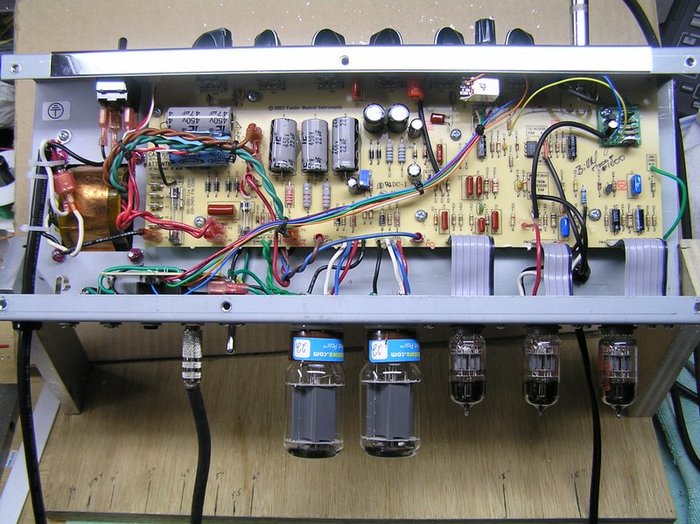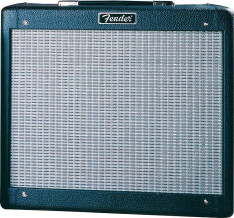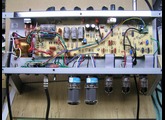View other reviews for this product:
« The affordable Fender sound »
Published on 04/07/15 at 09:21
Value For Money :
Correct
Audience:
Anyone
Overview
The Fender Blues Jr. is easily one of Fender's most popular guitar amplifiers of the past decade. In addition to the classic black tolex model, there have been several limited edition releases over the years as well--often equipped with different speakers or electronic mods to offer a unique spin on the original amp. The original amplifiers were produced in the USA, but production was later moved to Mexico to keep costs down and meet the high demand for this little charmer of an amp. Currently (in 2015) the Blues Jr. sells for about $530 brand new, but they are extremely easy to find secondhand for a good price if you take a little extra time to look around. For settings, the Blues Jr. has it all: input gain, master volume, treble, middle, bass, reverb (from the included spring reverb tank), and finally a "fat" toggle switch that acts as mid-range/gain boost to the overall signal.
The Blues Jr.'s popularity is due, in part, to the fact that it's a solid, affordable tube-powered amplifier, which is often considered a step up from solid state amps (depending on who you ask). As its name suggests, the Blues Jr. has been tailored to suit blues and rock genres, and it definitely does what its supposed to. The Blues Jr. is powered by two EL84 tubes, and driven by three 12ax7 preamp tubes (although this is the stock setting…the 12ax7's may be substituted for other tubes…more on this later). The stock tubes can be easily dialed to produce the "warm, crunchy tone" that many blues and rock guitarists are looking for in a tube amp, which cannot be fully replicated by solid state amplifiers (I say this from experience). Another reason for this amp's popularity is its ability to retain tone and overdrive at low volume levels, making it a great practice amp for apartments, dorms, and houses with napping babies. No wonder this amp appeals to such a wide audience.
My Experience
Unfortunately, I bought my (Mexican made) Blues Jr. in (very) used condition, and that came with its own set of issues. Luckily, I was able to fix most of the problems myself with a lot of research and a little soldering (with repairs/parts, I paid about $325 total for the amp…still a good deal). My Blues Jr. also came with dying stock tubes, so I later replaced the stock EL84's and 12ax7's for a different set-up, but I will quickly touch on the stock tube sound.
My favorite aspect of the Blues Jr., which I have mentioned above, is that it can sound good at low volumes (as well as high volumes). In my opinion, this amp can be used for practice in the bedroom, recording in the studio, and even live amplification at a gig with a microphone on the cabinet (some would disagree with this, but they're probably thinking of playing in a freakin' huge stadium). The stock tubes can stay bright and clean with the gain rolled back and the master volume cranked. On the other hand, diming the gain and rolling back the master volume creates a powerful tube-driven overdrive that is not too harsh on the ears. The only problem in my case was that my used amp (before I fixed it) would occasionally give out and stop working, or it would start making loud cracking noises. This leads us to the next phase of my Blues Jr…
After making the necessary adjustments and replacements my Blues Jr. was back up and running, but this time I added a new combination of tubes to change things up. I replaced the stock Groove Tube EL84's with two Mullard EL84's, and I replaced the stock 12ax7's with two JJ 12ax7's and one Electro-Harmonix 12ay7 (in the V1 position). The reason I chose these tubes is two-fold: 1) I already had the EL84 tubes on hand and I needed affordable replacements for the preamp tubes, and 2) I wanted a combination of preamp tubes that would make my Blues Jr. less prone to naturally overdriving… this is where the EH 12ay7 comes in.
12ax7's are known for their ability to overdrive easily and create classic tube distortion. The Blues Jr. comes with three of them, but only one really works to create this overdriven sound--the preamp tube in the V1 position (in the image below, the tube on the very right)

Image provided by Billmaudio.com
For my own guitar rig I use a pedal board with several effects, including overdrive, delay, and reverb. When I would play them through my Blues Jr. at high volumes the pedal sounds would be influenced by the overdriving 12ax7 in the V1 position. I did some research and found out that the high gain 12ax7 could be replaced with a lower gain 12ay7, which roughly uses about 70% of the power a 12ax7 uses (in simple layman terms). In other words, I could simply replace one tube and instantly have a "cleaner" amp, less prone to overdriving at higher volumes. The Blues Jr. works on a 'fixed bias,' so swapping out tubes is extra easy--the fixed bias eliminates the need for bias adjustment with a new set of tubes, which is an area of electronics outside of my expertise. Since I have made these changes, I have yet to run into any real problems with my Blues Jr. amp.
A Few Objective Observations
Though my experience with my own Blues Jr. has been complicated at best, I do have a few objective observations to share (I have played several of these amps in different stores and borrowed a few from friends).
First, I have really never been impressed by the EQ and tone settings on the amp. The treble and bass settings have a fair amount of flexibility, but the middle control in particular has never made a difference to my ears. I've tried cranking it up and rolling it back, and it barely produces any variance in sound. As far as I'm concerned, the Blues Jr. would be better off without it.
Second, the stock speaker and cabinet combination could definitely be better. Granted, my Blues Jr. was purchased very used. But even on other stock Blues Jr.'s I have not been impressed by how the cheaply made cabinet projects sound from the stock Eminence speaker. This may be more of a flaw in the cabinet design than the speaker itself, but I have heard the Celestion Vintage 30 is a popular replacement for the stock speaker.
Finally, despite its design flaws, the Blues Jr. does offer a lot of bang for the buck. Though it's only a 15W amplifier, the Blues Jr. can be as loud or quiet as you need it to be. It's definitely a modern Fender amp, but it can still be dialed to capture the classic chimey tone that Fender is so famous for.
Bottom-Line
The Blues Jr. is a solid tube amp for an affordable price. It does not offer the same world-class tone and flexibility as high-end tube amps, but its a good alternative for the average joe who does not have $1,000 or more to spend.
The Fender Blues Jr. is easily one of Fender's most popular guitar amplifiers of the past decade. In addition to the classic black tolex model, there have been several limited edition releases over the years as well--often equipped with different speakers or electronic mods to offer a unique spin on the original amp. The original amplifiers were produced in the USA, but production was later moved to Mexico to keep costs down and meet the high demand for this little charmer of an amp. Currently (in 2015) the Blues Jr. sells for about $530 brand new, but they are extremely easy to find secondhand for a good price if you take a little extra time to look around. For settings, the Blues Jr. has it all: input gain, master volume, treble, middle, bass, reverb (from the included spring reverb tank), and finally a "fat" toggle switch that acts as mid-range/gain boost to the overall signal.
The Blues Jr.'s popularity is due, in part, to the fact that it's a solid, affordable tube-powered amplifier, which is often considered a step up from solid state amps (depending on who you ask). As its name suggests, the Blues Jr. has been tailored to suit blues and rock genres, and it definitely does what its supposed to. The Blues Jr. is powered by two EL84 tubes, and driven by three 12ax7 preamp tubes (although this is the stock setting…the 12ax7's may be substituted for other tubes…more on this later). The stock tubes can be easily dialed to produce the "warm, crunchy tone" that many blues and rock guitarists are looking for in a tube amp, which cannot be fully replicated by solid state amplifiers (I say this from experience). Another reason for this amp's popularity is its ability to retain tone and overdrive at low volume levels, making it a great practice amp for apartments, dorms, and houses with napping babies. No wonder this amp appeals to such a wide audience.
My Experience
Unfortunately, I bought my (Mexican made) Blues Jr. in (very) used condition, and that came with its own set of issues. Luckily, I was able to fix most of the problems myself with a lot of research and a little soldering (with repairs/parts, I paid about $325 total for the amp…still a good deal). My Blues Jr. also came with dying stock tubes, so I later replaced the stock EL84's and 12ax7's for a different set-up, but I will quickly touch on the stock tube sound.
My favorite aspect of the Blues Jr., which I have mentioned above, is that it can sound good at low volumes (as well as high volumes). In my opinion, this amp can be used for practice in the bedroom, recording in the studio, and even live amplification at a gig with a microphone on the cabinet (some would disagree with this, but they're probably thinking of playing in a freakin' huge stadium). The stock tubes can stay bright and clean with the gain rolled back and the master volume cranked. On the other hand, diming the gain and rolling back the master volume creates a powerful tube-driven overdrive that is not too harsh on the ears. The only problem in my case was that my used amp (before I fixed it) would occasionally give out and stop working, or it would start making loud cracking noises. This leads us to the next phase of my Blues Jr…
After making the necessary adjustments and replacements my Blues Jr. was back up and running, but this time I added a new combination of tubes to change things up. I replaced the stock Groove Tube EL84's with two Mullard EL84's, and I replaced the stock 12ax7's with two JJ 12ax7's and one Electro-Harmonix 12ay7 (in the V1 position). The reason I chose these tubes is two-fold: 1) I already had the EL84 tubes on hand and I needed affordable replacements for the preamp tubes, and 2) I wanted a combination of preamp tubes that would make my Blues Jr. less prone to naturally overdriving… this is where the EH 12ay7 comes in.
12ax7's are known for their ability to overdrive easily and create classic tube distortion. The Blues Jr. comes with three of them, but only one really works to create this overdriven sound--the preamp tube in the V1 position (in the image below, the tube on the very right)

Image provided by Billmaudio.com
For my own guitar rig I use a pedal board with several effects, including overdrive, delay, and reverb. When I would play them through my Blues Jr. at high volumes the pedal sounds would be influenced by the overdriving 12ax7 in the V1 position. I did some research and found out that the high gain 12ax7 could be replaced with a lower gain 12ay7, which roughly uses about 70% of the power a 12ax7 uses (in simple layman terms). In other words, I could simply replace one tube and instantly have a "cleaner" amp, less prone to overdriving at higher volumes. The Blues Jr. works on a 'fixed bias,' so swapping out tubes is extra easy--the fixed bias eliminates the need for bias adjustment with a new set of tubes, which is an area of electronics outside of my expertise. Since I have made these changes, I have yet to run into any real problems with my Blues Jr. amp.
A Few Objective Observations
Though my experience with my own Blues Jr. has been complicated at best, I do have a few objective observations to share (I have played several of these amps in different stores and borrowed a few from friends).
First, I have really never been impressed by the EQ and tone settings on the amp. The treble and bass settings have a fair amount of flexibility, but the middle control in particular has never made a difference to my ears. I've tried cranking it up and rolling it back, and it barely produces any variance in sound. As far as I'm concerned, the Blues Jr. would be better off without it.
Second, the stock speaker and cabinet combination could definitely be better. Granted, my Blues Jr. was purchased very used. But even on other stock Blues Jr.'s I have not been impressed by how the cheaply made cabinet projects sound from the stock Eminence speaker. This may be more of a flaw in the cabinet design than the speaker itself, but I have heard the Celestion Vintage 30 is a popular replacement for the stock speaker.
Finally, despite its design flaws, the Blues Jr. does offer a lot of bang for the buck. Though it's only a 15W amplifier, the Blues Jr. can be as loud or quiet as you need it to be. It's definitely a modern Fender amp, but it can still be dialed to capture the classic chimey tone that Fender is so famous for.
Bottom-Line
The Blues Jr. is a solid tube amp for an affordable price. It does not offer the same world-class tone and flexibility as high-end tube amps, but its a good alternative for the average joe who does not have $1,000 or more to spend.





